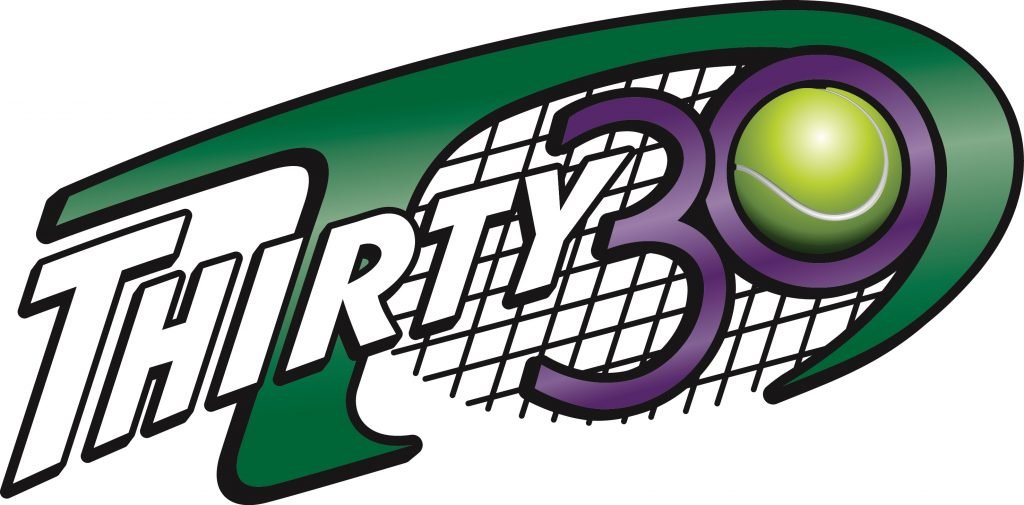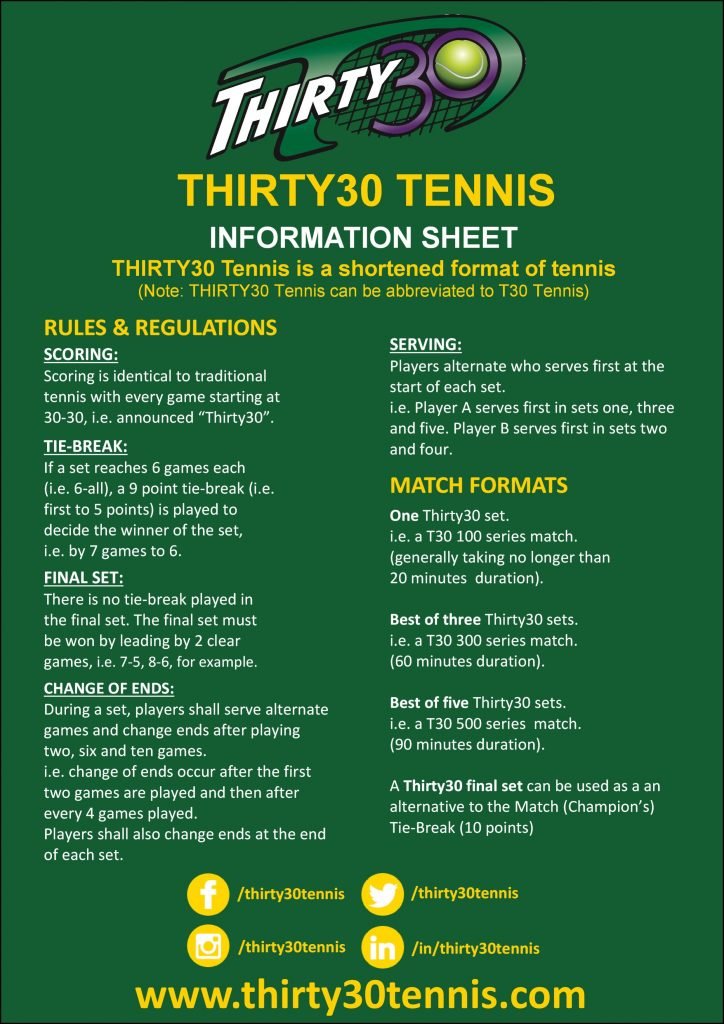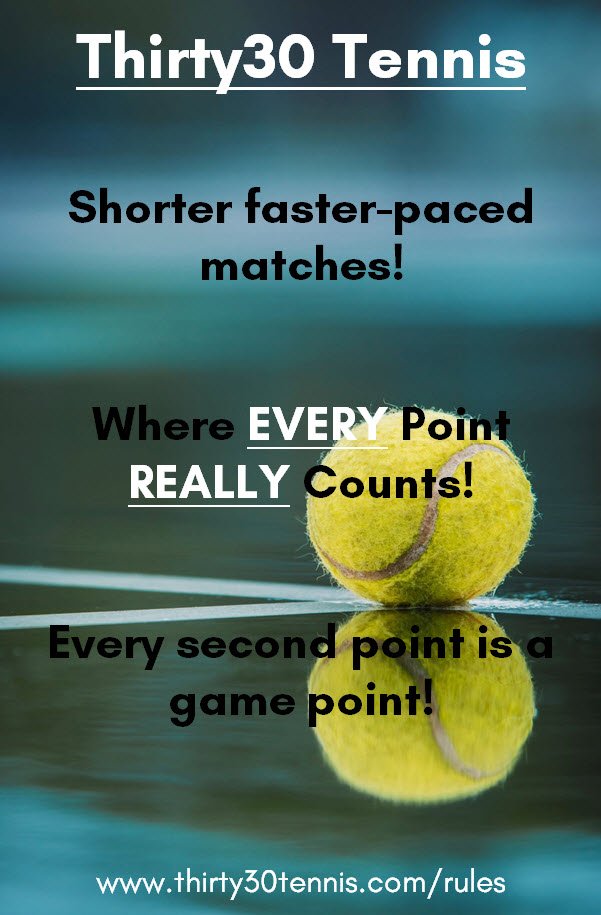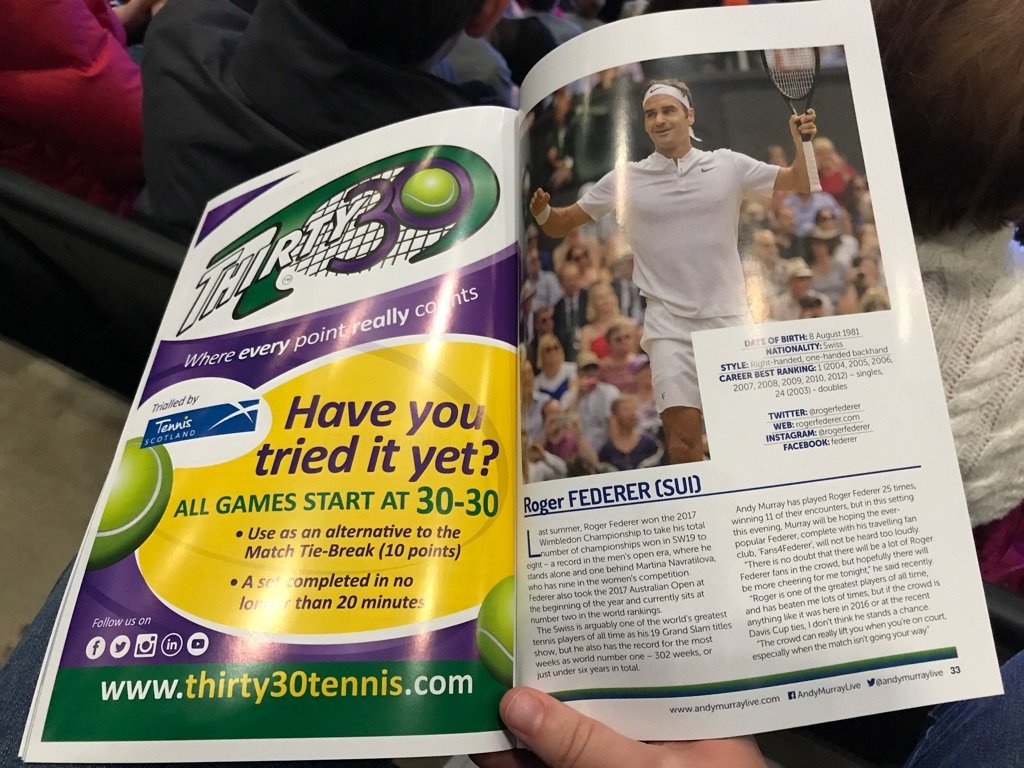Thirty30 Tennis is a shortened format of tennis where every point counts, inspired by T20 cricket, this format is part and parcel of the evolution of the game in contemporary times.
In this feature piece for our sports tech & entrepreneurship section, we caught up with founder, Mark Milne, to talk about why he started this version of the game, and where his journey with it has taken him.

Zushan Hashmi: Tell me a little bit about your own background in tennis? How did you get involved with the sport?
Mark Milne: For almost 50 years I have had a great passion for racket sports, in particular tennis, squash, and badminton, all of which I have played to a County level.
My great love for tennis started following a family holiday to Scarborough in July 1972 where I watched the five sets Wimbledon men’s final between Stan Smith & Ilie Nastase on a small black and white television. We went out and bought some very cheap Winfield branded tennis balls and wooden rackets from the local Woolworth’s store over the road, found some grass tennis courts, had a knockabout and that was me hooked.
The family returned back home to Arbroath, we called round to the local tennis club that had 3 blaes courts (similar to red clay) and was only a 5-minute walk from the family house.
It was halfway through the tennis season and I was delighted to become a member of the club for a remaining couple of months of the season for a massive membership fee of only £1!
I went home delighted, clutching the small membership card with my name on it and signed by the President of the club like it was a piece of treasure.
I was also very lucky to find that I had a natural ability for tennis. It all came very easily to me and I was quick around the court.
Watching Bjorn Borg win his 5 Wimbledon titles in a row from 1976 – 1980 had an enormous influence on me during my teen years as he was the perfect role model – the wooden Donnay racquets!
The tightly strung racquets whose strings popped during the night! The topspin! The sliced backhand! The white tennis balls! The long rallies! The subtle touch and finesse!
The standing at the umpire’s chair during the change of ends! – all just memories for us now!
In the winter months back then, the people who played tennis during the decent summer months tended to move indoors away from the cold Scottish winter weather to play either badminton or squash.
There were local badminton and squash clubs that I joined and again found that I also had a natural talent for both.
I played tennis, squash, and badminton for the local club’s teams in the local leagues over a period of over 30 years and also competed in many local competitions, winning numerous local events.
I was the Scottish Squash National coach/manager to the boys under 14 & 16 teams in the early 1990s competing in the Home Internationals against England, Ireland, and Wales.
I stopped playing competitively over 15 years ago and now just play a couple of times a week for fun and exercise.
Where did the idea of Thirty30 Tennis spark from?
During the 1980’s/1990’s the game of Short or Soft tennis was introduced in the UK as a starting point for any junior wanting to learn how to play tennis.
It was played indoors on a smaller (badminton) court, over a low net with a soft sponge ball that did not bounce very high and with a solid plastic (with holes) racket/bat.
I had played this as an adult at the time and had found it to be great fun.
Around 4 years ago and after over 10 years playing the same opponent regularly twice a week at squash during the winter months to keep fit, we called it a day.
I was looking for something different to do indoors during the winter months and came across the fantastic sport of Touchtennis.
Touchtennis was invented by Rashid Ahmad in the early 2000s and is very similar to Short Tennis, however a racket (usually a 21”) with strings is used and the sponge ball used has had a makeover and is now heavier, denser, faster and bounces a lot higher.
I got together with a hitting partner and we started playing one-hour Touchtennis twice a week on a regular basis.
Initially, the scoring system we used was the “old” Short tennis scoring, i.e. alternate 2 serves each, one from each side (Left / Right), point per rally scoring with the game won when the first player gets 11 points (lead by 2 points), best of 3 games.
This scoring was satisfactory for a short period of time but the game of Touchtennis had now moved up a gear from the game of Short Tennis. It did feel like a shrunk-down version of tennis in that the overhead serve was bigger and was a weapon, the sponge ball behaved more like a tennis ball, was much faster, bounced higher, took topspin, slice, serve & volley was possible, etc.
We started using the traditional tennis scoring system, i.e. best of 3 sets, 0, 15, 30, 40, Ad, Game, sets to 6 games etc. Yet, again after a short period of time, we found that quite often we were not completing the match due to being restricted to the one-hour court booking time slot.
I researched the official rules of Touchtennis and learned that they were very similar to Tennis Australia’s Fast4 rules, i.e. sets to 4 games, TB at 3-3, No Ads (i.e. ‘sudden-death’ deuce) & No Lets.
This just did not sit right with me. Playing sets to 4 games with No Ads was just not tennis to me. Although now completing a best of 3 sets match within the one hour, on leaving the court having won by e.g. 4-1, 3-4, 4-2, it just didn’t feel right; this was not tennis as I knew it.
Then, early March 2016 I woke up suddenly in the middle of the night with what I now call a “light-bulb” moment – we could complete the best of 3 sets match in under an hour if we played normal traditional tennis scoring except that every game would start at 30-30.
I had remembered from my junior days that 30-30 starts had been used during practice to give the players more experience of playing the “big” points. I was also aware that the faster and more exciting version of cricket called Twenty20 (T20) was being played and was very successful.
When I looked at “30-30”, the most obvious thing to do was to brand the new shorter and more exciting version of tennis as “Thirty30” (T30) tennis - the clue would be in the name – every game starts at 30-30 (i.e. 30-all) and “thirty-thirty” is announced at the start of every game to differentiate the T30 format from the traditional scoring format! Thirty30 would be referred to as being the younger sibling of Twenty20.
We started using Thirty30 and with a bit of experimenting with when to change ends I altered the ‘change of ends’ rule slightly from the traditional “after one and every two games” to “after two and every four games”.
Players still served alternatively but this meant that both players would play a service game before initially changing ends and followed by changing ends after every 4 games played. i.e. change of ends occurs after 2, 6, and 10 games, ensuring a maximum of only 3 changes of ends per set.
This also made the match shorter and the court time was used more efficiently.
Another very small change was what to do when a set reached 6 games all. Initially, a traditional Tie-Break to 7 points (lead by 2) was used but this could go on too long.
A “Golden Game” was created that was essentially a “sudden-death” game played at 6-all.
However, this was not ideal and it was finally decided that a “Short Set Tie-Break” i.e. best of 9 points (maximum 9 points played), first to 5 points, ‘sudden-death’ point at 4-4, would be played at 6 games all to decide the set.
Lastly, I wanted to alternate who serves first at the start of each set. In a 3 set T30 match, player A serves first in sets #1 & #3 and player B serves first in set #2.
I felt that this made the format fairer. In traditional tennis it is pretty random - if a set is concluded after an even number of games have been played, i.e. 6-0 or 6-2 or 6-4 or 7-5 then the player who served first in that set will serve first again in the next set.
And in sets that end either 6-1 or 6-3 or 7-6 will the other player start serving in the next set. I wanted to even things up. We began using this format and found that invariably the best of 3 sets match could be completed in the hour and you could leave the court having won e.g. 7-6(3), 3-6, 7-5 with the match actually feeling, looking and sounding like a traditional match.
I then conjured up “Thirty30 Tennis – Where Every Point Really Counts” as every second point played is a game point. The Thirty30 matches were shorter, faster-paced, and more dynamic – the game score ticked over much more quickly and it was great fun!
READ: ParentingAces: Guiding parents & children through tennis with Lisa Stone
How does a shorter format, such as this, enable the sport to grow?
The sport of tennis is well-liked across the world. It is a sport with truly global proportions. It is also one of the major sports with strong traditions and little changes in its evolution.
In the competitive world of professional sports, I believe tennis is failing to earn a new generation of young fans. Blame it on popular cultural trends or decreased attention span, it is what it is.
One of the changes I would like to see is shortening the length of tennis matches. I strongly believe that a change is needed to make tennis more dynamic and more attractive to millennials and Generation Z. Even the die-hard tennis fans do not have time or patience to watch every second of ‘best of 5 sets’ matches that last 4 hours straight.
It is time for tennis to speed up. Speeding up matches by using Thirty30 will work well to generate more excitement and help players to rest and recover faster. It will also attract a younger generation to tennis which is vital for any sports to grow, and to capitalize on.
The shorter format can also help encourage players who have stopped playing to start playing again as the required time commitment is less, matches are less physically demanding, and more matches can be played in the same time-frame thus meeting many more different opponents.
Thirty30 Tennis starts every game at 30-all, so you play fewer points to complete a game. It sounds and feels like regular tennis with sets still going to 6 games.
If a set is to reach a score of 6-6, a nine-point tie-break, first to 5 points and sudden death at 4-4, is utilized. The Thirty30 match format is ‘best of 3 sets’ or ‘best of 5 sets’ and there is no final set tie-break.
With the Thirty30 tennis format, sets are estimated to take no longer than 20 minutes, so a ‘best of 3 sets’ match can be completed in an hour (and a ‘best of 5 sets’ match in around 90 minutes). This is a perfect length of time for a sporting event to play recreationally or to stream and enjoy from anywhere in the world.
Tell us a bit more about the advantages of this form of tennis?
Thirty30 tennis does not upset the fundamental scoring system of tennis and retains:
- sets to 6 games (lead by 2); e.g. a best-of-3 sets match can be won by 7-6(3), 2-6, 8-6, i.e. the match score looks identical to that produced using the traditional scoring method.
- the deuce/advantage points exchanges.
- the tie-break played at 6-games all to decide a set.
- winning “2 points in a row” are still required to win a game
- the “no-tie-break / lead by 2 games” to win the final set.
Thirty30 tennis produces:
- faster, more “bite-size” intense periods of play, ideal for television/streaming.
- shorter matches or events that are less physically demanding, easier on the body and helps longevity.
- tennis matches that still FEEL, LOOK and SOUND like traditional tennis matches, but are shorter in duration and are faster paced.
- more unpredictable sets. It is easier to break serve – the receiver has to win only one out of the first two points played to take a game to deuce.
- matches that are still long enough to provide a fair test of skill and ability where the better player still generally wins. This is very important to me going forward, as any shorter format has to be credible and accepted by the competing players, spectators and viewers.
Advantages of Thirty30 tennis are:
- the transition from the traditional scoring method to the Thirty30 scoring method and back again is seamless for players, audiences and officials. The rules are extremely similar and very simple.
- full focus and concentration is required 100% of the time. There is no opportunity to switch off. The overall quality of a Thirty30 match is higher.
- there are less meaningless points and less dead periods during a match.
- matches build in a similar fashion to traditional tennis.
- a great way for kids to develop ‘game’ (the deuce/ad grind) and ‘set’ and ‘match’ (momentum swings) play.
- helps promote more ‘game-based style of coaching’ by encouraging players to play the shorter Thirty30 sets.
- a greater number of Thirty30 matches can be completed in the same time, e.g. a tournament ‘Session’ will have more matches and spectators will see more players compete.
- the shorter length matches to ensure a quicker turnaround of matches and is ideal for round-robin and compass draw format events, i.e. players will play more matches against more opponents in the same time.
- women can play best-of-5 sets tennis matches as well as the men - this would be very interesting!
- “Thirty30” is instantly recognizable as being associated with tennis - the clue is in the name - every game starts at 30-30!
Thirty30 tennis can be used:
- to reinvigorate tennis and to attract youngsters again to start (and keep) playing.
- for social / mixer club events.
- during a typical indoor or outdoor court booking time-slot of one hour, a best-of-3 sets Thirty30 match can be completed.
- when competitions/tournaments or events have suffered from rain delays and matches are required to be shortened in order to complete the event.
- where competition referees are limited with the number of courts and too little time.
- to shorten inter-club league’s match nights.
- for Exhibition, Pro/Am, Legends/Seniors events, as crowd warm-up matches at major events.
Maintaining the traditions of tennis is key to any success with shorter formats in the future, and retaining the best bits - sets to 6 games’ and ‘tie-breaks at 6 games all’ and playing the ‘Ad-points’ - are crucial to that success.

Do you believe that Thirty30 Tennis is a natural evolution of the game? If so why/why not?
Yes, all sports and not only tennis have to constantly take a look at themselves in order to adapt to stay relevant to modern society and to attract new participants and spectators and appease broadcasters.
One of the most common methods being used is alternative shorter methods that create faster-paced more exciting sport.
Racket sports similar to tennis like squash, badminton and table tennis have all changed their scoring methods in an effort to evolve.
Others include Cricket (Twenty20/T20, T10, The Hundred), Golf (GolfSixes), Netball (Fast5), Tennis (Fast4 and Tie Break Tens), Rugby (Sevens), Basketball (3×3), Athletics (Nitro).
Below is an excerpt, taken from an online article where Chris Kermode, the departing head of the ATP, was speaking at the ATP Finals in London (2019) and where he discussed innovation and his biggest issue: Where is the Next Generation of Fans?
The growth of the ATP Finals, which has thrived at the O2 in London, the birth of the Next Gen Finals and the soon to arrive ATP Cup are all projects that Kermode will look back on fondly. Innovation, he feels, may be necessary to capture a new generation of fans beyond the golden era of Roger Federer, Rafael Nadal, Novak Djokovic and Andy Murray. The game will carry on when Roger, Rafa, Novak and Andy all leave. They have played an immense part and are obviously going to be missed but the game will survive and the talent that’s coming through is incredible. ‘But the biggest issue for me is where is the next generation of fans? That’s really what that event [Next Gen Finals] was designed for was to just test potential ways that the game “could”, and I emphasize the “could look” in the future. I’m not advocating, by the way, that the Slams ever change from a five-set format, because it’s brilliant and it works. But I think there is an opportunity for the sport to have different formats, like cricket [Twenty20] and other sports do it. The sport has got to look ahead for the next 10 years. My children in their 20s, just how they consume any entertainment is completely different to how I did and how we all did. The game has to adapt. People fundamentally don’t like change but change will only happen when the sport faces not a crisis but maybe a reset… it’s difficult to get people to make those changes now when it’s going up, because they say, “Well, why change?”
I totally agree with these comments, “Tennis has to adapt!”
Do you think it’s better suited like that, or as an alternative?
In tennis, shorter formats should only ever be used as and when required as an alternative to traditional scoring.
The history of traditional scoring must be maintained and Grand Slams and ATP 1000 events should stay as they are as these events must remain as the ultimate tests in tennis and must not change.
What has the response to this new format of tennis been like?
The response has been very encouraging with people from all over the world using and liking the format. There are now almost 270 Testimonials on the Thirty30 tennis website.
What do you think needs to be done for it to grow further?
In order to grow Thirty30 further, my goal is to get Thirty30 “approved by the ITF for trial purposes only at a limited number of tournaments or events and/or for a limited time period” as per the ‘Foreword’ in their Rules of Tennis.
Are you recognised by any official bodies or in the process of that?
Please let me explain where I am with T30.
I started my Thirty30 crusade following my “light-bulb” moment in March 2016. I realised that I wanted to trial my idea and at this time I met up with the then acting CEO of Tennis Scotland – he liked the idea and told me that Tennis Scotland would help me.
I also thought, who is the best person in Scotland that could possibly help me trial Thirty30? And that was, of course, Judy Murray!
I contacted her during the summer of 2016. She told me that she had used 30-30 game starts for fun, was supportive of my idea, however, she had many other projects on her to-do list and she wished me good luck with my idea before suggesting that I contact the Head of Competitions at the International Tennis Federation (ITF).
I contacted the ITF basically just through the “Contact Us” on their website and I was eventually put in touch with the Head of their Rules of Tennis Committee. He discussed T30 with a couple of his colleagues and came back to me asking me to officially apply by completing their document “Application to amend Rules of Tennis”.
At this point in time, the T30 Rules included the ‘Golden Game’ played at 6 games all which was subsequently changed to the ‘9-point tie-break’ after initial trialling based feedback was received at the start of 2018.
I completed the form, sent it off to the ITF and was later informed that my application would be on the agenda for discussion at their next Rules of Tennis Committee meeting to be held in Paris in June 2017 during the French Open.
In early July, I received a letter from the ITF telling me that the committee had decided not to put Thirty30 forward to the Board for consideration as their Rules already had enough alternative methods for shortening tennis matches.
I consulted their 2017 Rules and in Appendix V there is a section called “Alternative Procedures and Scoring Methods”.
Within this section was listed the following rules: “No Ads”, Short Sets (to 4 games TB at 3-3), Match Tie-Break (7 points), Match Tie-Break (10 points) and “No Let” and also that “For a two-year trial (2016-17) the alternative FAST4 format may be used”.
I pointed out that sets to 4 games with no ads and the use of the Match Tie-Break (10 points) as a 3rd set match decider was just not tennis as we traditionally know it.
I felt that the alternative shorter Thirty30 scoring format was better as it is faster paced and retains the very important traditions of tennis better, i.e. sets to 6 games, tie-break at 6 games all, and the Deuce/Ad points are played out in full and that Thirty30 matches still feel, look and sound like traditional tennis.
I also pointed out that “Thirty30” actually means something and that most people would not recognise the connection between tennis and “Fast4”. I told the ITF that I would go away, get T30 trialled all over the world and then re-apply at some time in the future.
At the end of 2017 I started contacting people through social media explaining the Thirty30 tennis project and asking them to try using the shorter scoring method and to send me feedback.
Trialling has been ongoing for over two years and feedback has been very encouraging with youngsters especially liking the faster-paced format
In the Foreword of the 2020 ITF Rules of tennis is the following:
Appendix V lists all known and approved alternative procedures and scoring methods. In addition, on its own behalf or on application by interested parties, certain variations to the rules may be approved by the ITF for trial purposes only at a limited number of tournaments or events and/or for a limited time period.
Such variations are not included in the published rules and require a report to the ITF on the conclusion of the approved trial.
The goal for me is to re-apply to the ITF using the ‘Application to Amend The Rules of Tennis’ form with ‘Proposed Amendments’ to ‘trial of a variation of an existing rule’, i.e.
SCORE IN A GAME (Rule 5 Variation): SHORT GAME - Every game shall start at 30-30.
Where “short games” are played, the shorter duration scoring format shall be known as “Thirty30” or “T30” tennis.
Where both “short games” and the “No-Ad” (sudden-death deuce) scoring method are played, the format shall be known as “Thirty30+” or “T30+” tennis.
CHANGE OF ENDS (Rule 10 Variation): In a match where “short games” are played, the players shall change ends at the end of the second, sixth and every subsequent fourth game of each set. The players shall also change ends at the end of each set.
ORDER OF SERVICE (Rule 14 Variation): Where “short games” are played, at the end of each game, the receiver shall become the server and the server shall become the receiver for the next game and players/team shall alternate who serves first at the start of each set.
SHORT SET TIE-BREAK GAME (APPENDIX V Variation): Where both a “Tie-Break Set” and “short games” are played, a “Short Set tie-break game” shall be used. The first player/team to win five points wins the “Game” and “Set”, with a deciding point if the score reaches four all.
If so, what is being done in that regard or if not, what needs to be done?
I am continuing to contact people through social media asking them to try Thirty30 in order to gain more feedback.
What has been one of the hardest things about launching Thirty30 tennis?
Tennis is just a hobby for me and I have a great passion for it.
I am a Mechanical Design Engineer with over 30 years of experience working in both the Steel and Oil & Gas Industries and finding enough time to spend on promoting Thirty30 tennis has been the hardest thing about launching Thirty30 tennis.
Currently, I am spending almost 100% of my spare time working on it.
And with maintaining its success?
To maintain the ongoing successful feedback I require to ensure that I have enough spare time to spend working on the project.
Would you say a lot of tennis is risk-averse of unwillingness to accept change in the sport? If yes, why? If no, why not?
I agree with this. It is very difficult to get people to accept change in any walk of life never mind tennis.
There is now a ‘reset’ with the current coronavirus pandemic situation where the WTA, ATP and ITF tours are suspended for the foreseeable future together with possible travel restrictions in the future.
There is a big window for innovation because there’s no live sport and won’t be for a while for the players and fans.
An opportunity for some privately organised exhibition matches using alternative match and event formats may be possible to take place where and when local government restrictions allow, and these can be attractive opportunities for players to play some competitive matches and earn some income.
Any live sport which takes place in the months to come will be a novelty and a welcome diversion during these days of restricted movement.
There is a window for innovation right now to create entertainment for fans and opportunities for players and alternative shorter faster-paced scoring methods can be trialled.
Tell me a little bit about what goes on in your daily routine to manage and run the organisation?
The “organisation” is just me alone and as I have said above, I spend almost 100% of my spare time working on it.

How do you find time outside of the sport and your passion, to recuperate and prepare for your busy schedule?
Outside of work, the sport of tennis is my hobby and passion and I use it to recuperate!
Any other thoughts or comments?
I 100% believe that alternative shorter formats are the future of tennis and can help the sport attract younger people into the sport which can only be good for everyone involved with tennis.
I list below various life lessons that can be learned from tennis and why youngsters should be introduced to tennis:
- To be successful.
- You are your worst enemy.
- Never ever give up.
- How to work under pressure.
- The mind is everything.
- You have second opportunities.
- Learn to lose.


